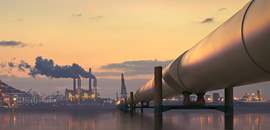In formulating public policy, political leaders need to forge a consensus about the urgency of a problem and then deliver a solution that does not create a new set of problems. In the case of climate change, public support has increased, and the Biden administration is taking steps to speed the transition from fossil fuels to alternative forms of energy. The big unknown is whether this can happen without creating an energy shortage and higher inflation.
A mid-2020 Pew Research Center poll found that nearly two-thirds of Americans surveyed saw the effects of climate change in their communities and felt the federal government was not doing enough to counter it. The proposals they favored include planting a trillion trees to absorb carbon emissions, providing tax credits to businesses to develop carbon capture technologies, taxing corporations, and increasing regulations on carbon emissions as well as developing alternatives to fossil fuels.
One question the survey did not ask was whether respondents would be willing to pay significantly higher prices for gasoline and heating oil. Steve Schwarzman of Blackstone and Larry Fink of BlackRock, a staunch advocate of environmental, social, and corporate governance (ESG), worry that the outflow of funds from the fossil fuel industry is too rapid and could result in ongoing shortages of energy.
In the United States, fossil fuels still account for 83 percent of energy consumption, and there were large-scale declines in capital spending on oil and gas production last year when prices plummeted during the pandemic. This marked a dramatic reversal from the previous decade, in which the oil and gas sector spent $1.2 trillion drilling and completing wells that increased by nearly 140 percent. According to the Federal Reserve Bank of Dallas, the drilling slowdown “makes it likely that U.S. output will struggle to reach its previous highs in coming years.”
Collectively, prices for oil, natural gas, coal, and electricity have nearly doubled since May. This reflects the recovery from the COVID-19 pandemic that has boosted energy demand, while policies in China to reduce coal output and in the European Union to foster green energy have curbed supply. Bank of America forecasts oil could hit $100 per barrel if winter is colder than normal.
Liquefied natural gas (LNG) is the main pressure point in Asia and parts of Europe, with prices having quadrupled in the past year. Bernstein, a market research firm, estimates that a shortage in LNG capacity globally could rise from 2 percent of energy demand now to 14 percent by 2030. It has already forced some European countries to encourage utilities to switch to coal to boost electricity production. It has also increased Russia’s leverage globally, as it supplies just over 40 percent of Europe’s gas imports with more to come as the Nord Stream 2 pipeline is opened. Meanwhile, U.S. exports of LNG have increased significantly, adding to upward pressures on oil prices.
The Economist calls it the “first big scare in the green era” and identifies several major challenges ahead. The most formidable is that investment in alternatives is considerably below the estimated $4 - $5 trillion needed to meet the Glasgow Summit target of becoming net carbon neutral by 2050. In 2020, global spending on renewable energy and transport was well shy of this total—in the vicinity of $500 billion.
The plan put forth in the $1.75 trillion Build Back Better (BBB) bill combines incentives to foster production of alternative energy sources with penalties and restrictions on fossil fuel production. The bill devotes about $550 billion to subsidize green energy, with $325 billion coming in the form of tax credits. It also entails increased regulation from the Environmental Protection Agency (EPA) for companies to control methane emissions. In addition, President Biden reportedly will impose restrictions on businesses to curb carbon emissions via executive orders.
What the bill does not include is a mechanism to price (or tax) carbon emissions, which many economists believe should be the centerpiece of a climate program.
In his 2018 Nobel laureate address, Professor William Nordhaus of Yale University spelled out the reasons. First and foremost, a carbon price is a way of internalizing carbon emissions, which are an “externality” that are not included in market prices. Second, it provides a means to assign a cost to the objective of reducing carbon emissions. Thus, Nordhaus observed that if the cost of limiting the global temperature increase to 1.5-2 degrees Celsius required deep reductions in living standards, “the policy would be the equivalent of burning down the village to save it.”
Although there is no consensus about the costs of tackling climate change, most economists believe a carbon tax is more efficient in dealing with emissions than government regulations. Yet previous attempts to introduce carbon pricing in the United States have been unsuccessful.
One may ask why this is so. The standard explanation is that a carbon tax is unpopular with the public because it would hurt low- and middle-income households. The rebuttal is that the revenues generated could be rebated to disadvantaged groups as a “carbon dividend.”
The case for establishing a carbon price often rests on two key considerations. First, it makes the costs transparent to the public and businesses so they can adapt their behavior. Second, it is much easier to administer than regulations that require businesses to spend considerable time and effort to be in compliance.
A third consideration is equally important. Namely, a carbon price can provide much-needed flexibility into a climate program to handle situations when the economy is at risk.
The pricing models for carbon that have been developed start with an initial price and adjust it upward annually—say by 5 percent per year. But a preferable approach would allow the price to fluctuate within bands as supply-demand conditions change, similar to buffer-stock schemes for commodities. In this way, climate policy can be adapted to lessen the risk of exacerbating economic weakness.
A version of this article was posted to TheHill.com on November 12, 2021.
A mid-2020 Pew Research Center poll found that nearly two-thirds of Americans surveyed saw the effects of climate change in their communities and felt the federal government was not doing enough to counter it. The proposals they favored include planting a trillion trees to absorb carbon emissions, providing tax credits to businesses to develop carbon capture technologies, taxing corporations, and increasing regulations on carbon emissions as well as developing alternatives to fossil fuels.
One question the survey did not ask was whether respondents would be willing to pay significantly higher prices for gasoline and heating oil. Steve Schwarzman of Blackstone and Larry Fink of BlackRock, a staunch advocate of environmental, social, and corporate governance (ESG), worry that the outflow of funds from the fossil fuel industry is too rapid and could result in ongoing shortages of energy.
In the United States, fossil fuels still account for 83 percent of energy consumption, and there were large-scale declines in capital spending on oil and gas production last year when prices plummeted during the pandemic. This marked a dramatic reversal from the previous decade, in which the oil and gas sector spent $1.2 trillion drilling and completing wells that increased by nearly 140 percent. According to the Federal Reserve Bank of Dallas, the drilling slowdown “makes it likely that U.S. output will struggle to reach its previous highs in coming years.”
Collectively, prices for oil, natural gas, coal, and electricity have nearly doubled since May. This reflects the recovery from the COVID-19 pandemic that has boosted energy demand, while policies in China to reduce coal output and in the European Union to foster green energy have curbed supply. Bank of America forecasts oil could hit $100 per barrel if winter is colder than normal.
Liquefied natural gas (LNG) is the main pressure point in Asia and parts of Europe, with prices having quadrupled in the past year. Bernstein, a market research firm, estimates that a shortage in LNG capacity globally could rise from 2 percent of energy demand now to 14 percent by 2030. It has already forced some European countries to encourage utilities to switch to coal to boost electricity production. It has also increased Russia’s leverage globally, as it supplies just over 40 percent of Europe’s gas imports with more to come as the Nord Stream 2 pipeline is opened. Meanwhile, U.S. exports of LNG have increased significantly, adding to upward pressures on oil prices.
The Economist calls it the “first big scare in the green era” and identifies several major challenges ahead. The most formidable is that investment in alternatives is considerably below the estimated $4 - $5 trillion needed to meet the Glasgow Summit target of becoming net carbon neutral by 2050. In 2020, global spending on renewable energy and transport was well shy of this total—in the vicinity of $500 billion.
The plan put forth in the $1.75 trillion Build Back Better (BBB) bill combines incentives to foster production of alternative energy sources with penalties and restrictions on fossil fuel production. The bill devotes about $550 billion to subsidize green energy, with $325 billion coming in the form of tax credits. It also entails increased regulation from the Environmental Protection Agency (EPA) for companies to control methane emissions. In addition, President Biden reportedly will impose restrictions on businesses to curb carbon emissions via executive orders.
What the bill does not include is a mechanism to price (or tax) carbon emissions, which many economists believe should be the centerpiece of a climate program.
In his 2018 Nobel laureate address, Professor William Nordhaus of Yale University spelled out the reasons. First and foremost, a carbon price is a way of internalizing carbon emissions, which are an “externality” that are not included in market prices. Second, it provides a means to assign a cost to the objective of reducing carbon emissions. Thus, Nordhaus observed that if the cost of limiting the global temperature increase to 1.5-2 degrees Celsius required deep reductions in living standards, “the policy would be the equivalent of burning down the village to save it.”
Although there is no consensus about the costs of tackling climate change, most economists believe a carbon tax is more efficient in dealing with emissions than government regulations. Yet previous attempts to introduce carbon pricing in the United States have been unsuccessful.
One may ask why this is so. The standard explanation is that a carbon tax is unpopular with the public because it would hurt low- and middle-income households. The rebuttal is that the revenues generated could be rebated to disadvantaged groups as a “carbon dividend.”
The case for establishing a carbon price often rests on two key considerations. First, it makes the costs transparent to the public and businesses so they can adapt their behavior. Second, it is much easier to administer than regulations that require businesses to spend considerable time and effort to be in compliance.
A third consideration is equally important. Namely, a carbon price can provide much-needed flexibility into a climate program to handle situations when the economy is at risk.
The pricing models for carbon that have been developed start with an initial price and adjust it upward annually—say by 5 percent per year. But a preferable approach would allow the price to fluctuate within bands as supply-demand conditions change, similar to buffer-stock schemes for commodities. In this way, climate policy can be adapted to lessen the risk of exacerbating economic weakness.
A version of this article was posted to TheHill.com on November 12, 2021.























